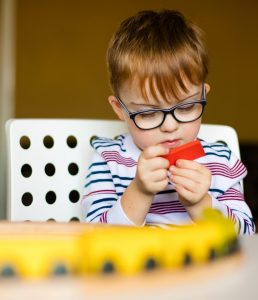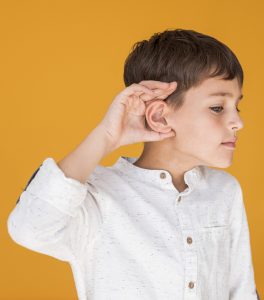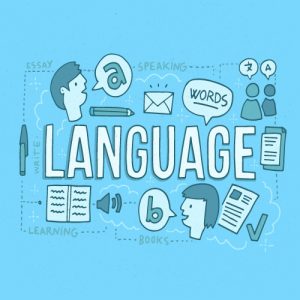By: Lisa Kota, MADS, BCBA and Natalia Plejic, BA, BST – Senior Therapists, AlphaBee ABA Programs.
Published in Autism Matters Magazine, Winter 2017, Volume 14, Number 1.
Every once in a while a visionary enters a field and makes an enormous impact. We at AlphaBee believe researcher and practitioner Francesca degli Espinosa, Ph.D., BCBA-D, CPsychol., is one of those special visionaries who is changing the course of autism intervention dramatically and for the better. She is doing so by solving some autism specific problems with some very simple strategies. Francesca employs a very technical behavioural analysis of language to develop her teaching procedures. The following is a review of a small portion of her work in everyday terms.
Learning to listen
One of life’s many miracles is the acquisition of language. Children typically go through a language explosion beginning at the age of 18 months. Children’s vocabularies increase dramatically at this time and they often need to hear a word only once to begin to add that word to their repertoire. Parents model language and respond to their children but do not have to explicitly teach their children how to speak. As children begin to combine words at around the age of two they are also able to attend to the questions and comments of others and quickly learn to provide answers that correctly match the questions they are asked.
Intensive Teaching for Children with Autism
Children with autism usually require intensive teaching to develop and expand their vocabulary. Instructors of children with autism initially select the most relevant words to work on. Children are taught to ask for their favourite items, talk about everyday items and family members, and learn to listen and respond when others use those words. Instructors of children with autism have to create opportunities for repeated practice of these words. When children with autism have acquired a useful vocabulary of 100 words or more and begin to use word combinations they are also expected to easily respond to questions that require answers that they regularly use within their vocabulary.

For example, if your daughter asks for her “purple dress” and you know that she can label all the colours as well as many items you would expect to be able to hold up a red dress and ask “What colour?” and have your daughter answer “red”. Yet many kids with autism who are at this stage of language development will answer “dress”. They appear to not be carefully listening to your question and are simply responding to the dress you are holding up.
In technical terms: they have not learned to discriminate the question, “What colour?” from the question, “What is it?” Why does this ability to attend to all the important information and ignore irrelevant information seem to happen easily for some children and create frustration for others? Could it be part of having autism? Or could it be our intensive teaching methods. We still don’t know the absolute answer to the discrimination problem, but Dr. degli Espinosa has given us a possible theory that also provides a useful solution.

How do we Listen?
The way we listen to others is by repeating their words to ourselves. Sometimes we simply repeat, and sometimes we put their words into our own words. You might frame this as active listening rather than passive listening and you are probably not aware of how often we engage language in this way. A frequent example would be when we must remember important information shared with us, but have no way of recording it. If someone tells you an address or a phone number you will repeat it to yourself until you have a pen and paper to jot it down. If someone asks you to pick up some items at the grocery store you will immediately repeat the list to yourself a couple of times and repeat it again in the store while you are collecting the items.
Research reviewed by Dr. degli Espinosa suggests that this crucial skill is typically deficient in children with autism, but that they can be taught to use this self talk to facilitate many skills including responding to complex multiple step instructions. To teach this task give the child the multiple step instruction and prompt the child to rehearse the instruction a few times before attempting to follow the instruction. As soon as children become consistently good at repeating various instructions they are almost immediately able to follow very complex novel instructions such as go to the art centre, get paper, glue, and some green glitter, and take it to the table. This procedure is an example of how children can be taught to listen to an instructor, and progress to listening to themselves. Dr. degli Espinosa has developed a related procedure to solve the discrimination problem that also requires listening to oneself.
Connecting a Question to an Answer
Questions require us to be able to respond to an auditory stimulus (the sound of the words spoken) but they almost always require us to attend to other information in our environment as well. If a child is shown a red dress and asked “What colour?” she needs to respond to what she heard as well as what she sees. She needs to match her answer to the question that she heard using visual information at the same time. Dr. degli Espinosa has developed a very effective procedure to teach children to do this. Initially children learn their vocabulary in the usual way with parents or instructors modelling single words at the moment children are attending to the items. Once a child has their basic vocabulary (and can vocally imitate two word combinations) Dr. degli Espinosa has developed a framework that intrinsically prompts correct answering.

When asked “What is it” children are taught to answer using the frame “It’s a__”. For example: a child is shown a ball and asked “What is it?”. The corresponding answer is “It’s a ball” instead of the single word answer. The question/answer combination of “What is it?” /“It’s a ____” is practiced repeatedly with already learned items until the connection is strong. The next step introduces a different question/answer combination, labelling colours. The child is shown a yellow colour swatch and asked “What colour?” He must answer “Colour yellow”. The question “What colour?” is connected to the response “Colour ____”, and is practiced with all the colours. This is then also applied to “what shape?”, “what number?” and “what letter?” Once children are consistently using these frames the discriminations are tested.
This systematic teaching method takes the “guess work” or rote learning out of answering discrimination question. It really is amazing to see children who have struggled with this discrimination problem begin to effortlessly answer these changing questions. If the child does make a mistake when asked “what number?” by answering “number green”, it immediately “sounds wrong” as those two words were never practiced in combination, so the child will correct himself. As children progress through this stage the instructors stop requiring them to include the frames. In other words, and instructor might ask “What colour” and allow the child to simply answer “blue”. This would occur after the child has been consistently correctly discriminating different questions about the same item for some time. Why is this procedure so effective? By repeating the last word of the question – whether out loud or silently- the child is using the framework to guide them to the right answer.
What Happened at School Today?
The work of Dr. degli Espinosa also addresses several other problems children with autism seem to struggle with. For example have you ever asked your child “What happened at school today?” Dr. degli Espinosa teaches that children with autism need to learn to label what is going on around them in order to be able to report those events to their parents after school. If a child is not regularly labelling events to himself it is unrealistic to expect him to be able to report those events several hours later.
During show and tell your child needs to learn to silently label to himself everything that is happening. Initially he will probably need someone to prompt him to do so by asking him questions such as “Whose turn is it?” “What item are they showing?” to get him to label what is happening in the moment. If he has labelled those activities in the moment he will be much more likely to be able to report those activities to his parents when he gets home. After repeated practice your child should begin to label to himself what is going on throughout his day. The assumption is that we adults engage in this type of verbal behaviour throughout our day. We talk to and listen to ourselves throughout our day. It is very empowering to realize that this self talk is very simply a skill that can be taught.

AlphaBee is excited to host Dr. Francesca degli Espinosa on March 25th -26th. For more information about our two-day conference, please visit https://events.alphabee.com/conference




